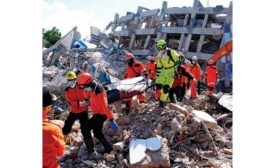Home » earthquake
Articles Tagged with ''earthquake''
Disasters
After Quakes, California Military Sites Resume Ops
Damage Assessment Teams Evaluating Remaining Structures
Read More
Strongest Earthquake in Years Hits Southern California
A 7.1-magnitude earthquake struck near Ridgecrest
Read More
Seismic Engineering
Anchorage Building Codes Credited for Limited Damage After Quakes
Why the latest Alaska earthquake didn't wreak more destruction
Read More
The latest news and information
#1 Source for Construction News, Data, Rankings, Analysis, and Commentary
JOIN ENR UNLIMITEDCopyright ©2024. All Rights Reserved BNP Media.
Design, CMS, Hosting & Web Development :: ePublishing










